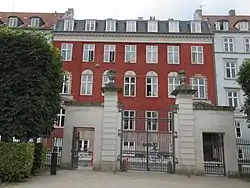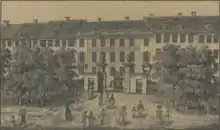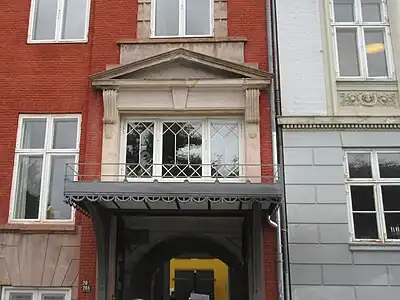Kronprinsessegade 20
Kronprinsessegade 20 is a Neoclassical property overlooking one of the entrances to Rosenborg Castle Garden in central Copenhagen, Denmark. It was listed on the Danish registry of protected buildings and places in 1945.
| Kronprinsessegade 20 | |
|---|---|
 | |
| General information | |
| Architectural style | Neoclassical |
| Location | Copenhagen |
| Country | Denmark |
| Coordinates | 55°41′1.01″N 12°34′56.34″E |
| Completed | 1806 |
| Design and construction | |
| Architect(s) | Jørgen Henrich Rawert and Andreas Hallander |
History
Early listory

Kronprinsessegade 20 was built by city builder Jørgen Henrich Rawert and Andreas Hallander in 1805–1806. The house was shortly thereafter sold to wine merchant Petges. His property was damaged during the British bombardment on 2–5 September the same year. He already moved in 1808.[1]
Christian Zartmann (1793-1853), a military officer, lived in the building in 1827. The naval officer C. D. von Hegerman-Lindencrone (1807-1893) was a resident in both 1830 and 1832.[2]
In 1832, Edward Brown (1787-) rented an 11-room apartment in the building. He was the youngest son of former Governor-General of Danish India David Brown. Edward Brown had returned to Copenhagen after making a fortune in the ingigo industry and on trade in India. He owned Gurrehus north of Copenhagen. He later suffered great loses on the bankruptcy of India-based Fergusson & Co.. In 1838, he emigrated to Australia.[3]
1834 census
Henry Wheaton, United States Chargé d'affaires, resided on the first floor at the 1834 census. He lived there with his wife Catharine Wheatonm their four children /aged seven to 16), two male servants and four maids.[4]
1840 census
The konferesnråd Peder Pedersen (1774-1851) resided in the ground-floor apartment at the 1840 census. He lived there with his wife Ane Caroline Pedersen (née Lugthon Smith, 1689s-1878(, their three children (aged eight to 13), one male servant and four maids.[5] The daughter Anne Sophy Pedersen (1824-1911) would later marry the lawyer Carl Christian Vilhelm Liebe(1820-1900). The two sons William and Julius would both become naval officers. Julius de Lancy Pedersen served as commandant of Christiansø. Consul Hambroe, who resided on the first floor, was in Finland with his family when the census took place. Only three maids and two male servants were therefore present in the home on the rfirst floor.[6] Sophie Elisabeth Holsten, widow of a general-lieutenant, resided on the second floor with her daughter Edle Sophie Holsten, 34-year-old Frederik Christian Holsten, a chamber maid, a female cook and a maid.[7] Anders Petersen, a concierge, resided in the basement with his wife Karen Olsdatter and their two children (aged five and nine).[8]
Alfred Hage
Alfred Hage, who had become a partner in H. Puggaard & Co. a few years earlier, lived in the building from 1843 to 1848. Hage was involved with the National Liberal movement and wrote for the magazine Fædrelandet.When the slesvig-holsten deputation came to Copenhagen in March 1848, Hage invited them to stay in his home in Kronprinsessegade. Studenterkorpset placed guards outside the building.[9]
The lawyer and politician C. C. W. Liebe (1820-1900) was a resident in 1850.
Julius Blom
In the 1860s the building was acquired by master carpenter and director of the Copenhagen Fire Department Julius Blom. Blom's father Thomas Blom had, back in the beginning og the century, together with his brothers and mother, as Bloms Enke & Sønner, constructed the nearby buildings at the corner of Kronprinsessegade and Dronningens Tværgade. He owned the property until his death in 1900.
Ahlefeldt-Laurvig family
The property was later acquired by the Ahlefeldt-Laurvig family for use as their city home. Christian Johan Frederik Ahlefeldt Laurvig and his wife Johanne Ida Augusta Ahlefeldt Laurvig resided in the building with a large staff at the 1906 census. Dagmar Regitze Kaas stayed there with them as their guest.[10]
Architecture
.jpg.webp)
Kronprinsessegade 20 is seven bays wide and has slightly progressing, one-bay corner risalits at each end. The wall between the two corner risalits has grey dressing on the high cellar while the upper three floors stand in red-painted, blank brick. The windows of the corner risalits on the bottom floor have framing and are topped by triangular pediments. The windows of the two corner risalits on the second floor are surrounded by rusticated framing while there are semi-curcilar Tympana over the five central windows. The roof is a slate-clad Mansard roof with seven dormers and five chimneys. An attica was removed in the middle of the 19th century. Under the roof runs a white-painted cornice supported by brackets.[11]
A rather clumpsy iron canopy over the gateway of the building doubles as a balcony on the first floor.
The gateway opens to a narrow courtyard. A four-storey, six-bay side wing extends from the rear side of the building along the north side of the courtyard. A nine-bay rear wing is located at the bottom of the courtyard.
Gallery
 Detail of the facade.
Detail of the facade. The two-storey rear wing.
The two-storey rear wing.
References
- Brask, Richard Høeg. "Familien Petges" (PDF) (in Danish). Personalhistorisk Ridsskrift. Retrieved 16 June 2022.
- "Kronprinsessegade 20-20a". indenforvoldene.dk (in Danish). Retrieved 4 August 2018.
- "Slægten Brown" (PDF). slaegtsbibliotek.dk (in Danish). Retrieved 16 June 2022.
- "Folketælling - 1834 - Henry Wheaton". Danishfamilysearch.dk (in Danish). Retrieved 15 September 2023.
- "Folketælling - 1840 - Peter Pedersen". Danishfamilysearch.dk (in Danish). Retrieved 15 September 2023.
- "Folketælling - 1840 - Maren Pederikke Nielsen". Danishfamilysearch.dk (in Danish). Retrieved 15 September 2023.
- "Folketælling - 1840 - Sophie Elisabeth Holsten". Danishfamilysearch.dk (in Danish). Retrieved 15 September 2023.
- "Folketælling - 1840 - Anders Petersen". Danishfamilysearch.dk (in Danish). Retrieved 15 September 2023.
- "Peter Alfred Anton Hage". finnholbek.dk (in Danish). Retrieved 5 August 2018.
- "Folketælling - 1906 - Christian Johan Frederik Ahlefeldt Laurvig". Danishfamilysearch.dk (in Danish). Retrieved 15 September 2023.
- "Sag: Kronprinsessegade 20" (in Danish). Kulturstyrelsen. Retrieved 5 August 2018.
%252C_ca._1856%252C_0083NMK%252C_Nivaagaards_Malerisamling.jpg.webp)